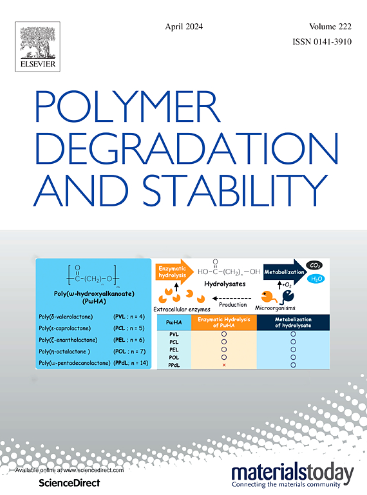Improvement of the durability of hydrogenated nitrile butadiene rubber sheets by adding phosphorylated cellulose nanofibers and metal (meth)acrylate
IF 6.3
2区 化学
Q1 POLYMER SCIENCE
引用次数: 0
Abstract
Nanocellulose materials are expected to partly replace petroleum-derived carbon black in rubber composites for the short-term improvement of their properties. In this study, phosphorylated cellulose nanofibers (P-CNFs) and hydrogenated nitrile-butadiene rubber (H![]() NBR) were oven-dried with or without metal (meth)acrylates, and the once-dried mixtures were kneaded and pressed to prepare cross-linked H
NBR) were oven-dried with or without metal (meth)acrylates, and the once-dried mixtures were kneaded and pressed to prepare cross-linked H![]() NBR/P-CNF/metal (meth)acrylate composite sheets. Neat H
NBR/P-CNF/metal (meth)acrylate composite sheets. Neat H![]() NBR and carbon-black-containing H
NBR and carbon-black-containing H![]() NBR composite sheets were prepared as references. In addition to the tensile and dynamic thermomechanical properties, the, hardness, abrasion resistance, degree of hysteresis loss, and hot water/organic solvent resistance of the composite sheets were evaluated. The properties of the P-CNF containing composite sheets were better than those of the neat H
NBR composite sheets were prepared as references. In addition to the tensile and dynamic thermomechanical properties, the, hardness, abrasion resistance, degree of hysteresis loss, and hot water/organic solvent resistance of the composite sheets were evaluated. The properties of the P-CNF containing composite sheets were better than those of the neat H![]() NBR sheet and carbon-black-containing composite sheets at the same P-CNF or carbon black content. The H
NBR sheet and carbon-black-containing composite sheets at the same P-CNF or carbon black content. The H![]() NBR/P-CNF/zinc methacrylate composite sheets showed the best performance in terms of not only the above properties, but also the hot water resistance, tensile properties, and abrasion resistance.
NBR/P-CNF/zinc methacrylate composite sheets showed the best performance in terms of not only the above properties, but also the hot water resistance, tensile properties, and abrasion resistance.

求助全文
约1分钟内获得全文
求助全文
来源期刊

Polymer Degradation and Stability
化学-高分子科学
CiteScore
10.10
自引率
10.20%
发文量
325
审稿时长
23 days
期刊介绍:
Polymer Degradation and Stability deals with the degradation reactions and their control which are a major preoccupation of practitioners of the many and diverse aspects of modern polymer technology.
Deteriorative reactions occur during processing, when polymers are subjected to heat, oxygen and mechanical stress, and during the useful life of the materials when oxygen and sunlight are the most important degradative agencies. In more specialised applications, degradation may be induced by high energy radiation, ozone, atmospheric pollutants, mechanical stress, biological action, hydrolysis and many other influences. The mechanisms of these reactions and stabilisation processes must be understood if the technology and application of polymers are to continue to advance. The reporting of investigations of this kind is therefore a major function of this journal.
However there are also new developments in polymer technology in which degradation processes find positive applications. For example, photodegradable plastics are now available, the recycling of polymeric products will become increasingly important, degradation and combustion studies are involved in the definition of the fire hazards which are associated with polymeric materials and the microelectronics industry is vitally dependent upon polymer degradation in the manufacture of its circuitry. Polymer properties may also be improved by processes like curing and grafting, the chemistry of which can be closely related to that which causes physical deterioration in other circumstances.
 求助内容:
求助内容: 应助结果提醒方式:
应助结果提醒方式:


